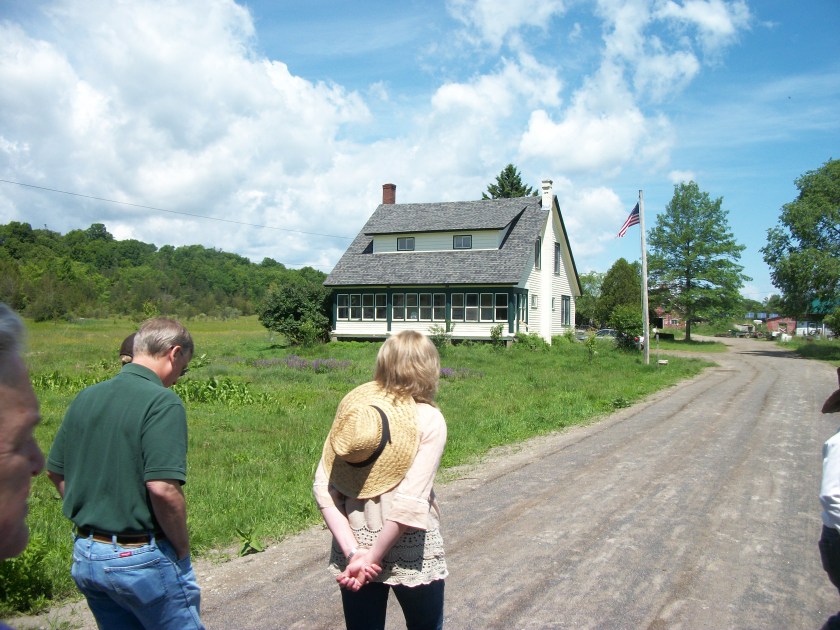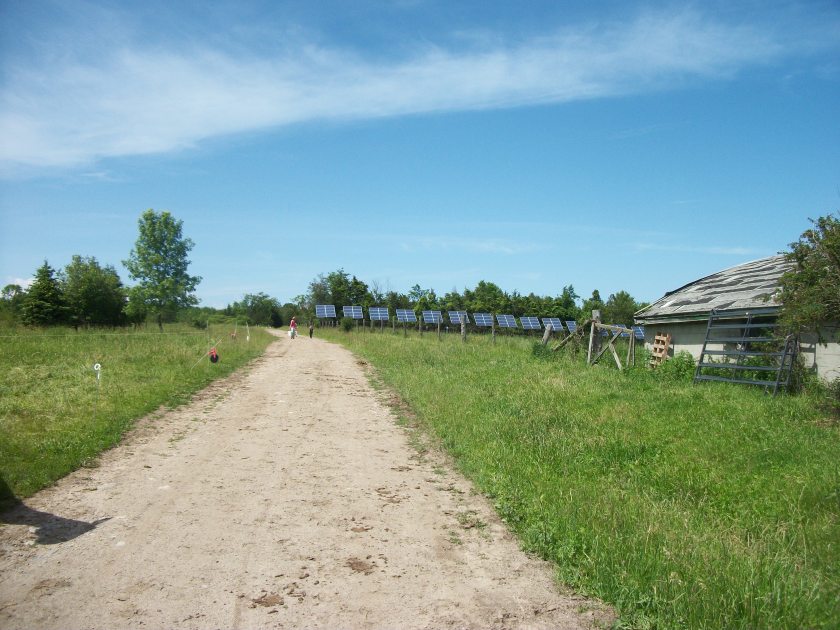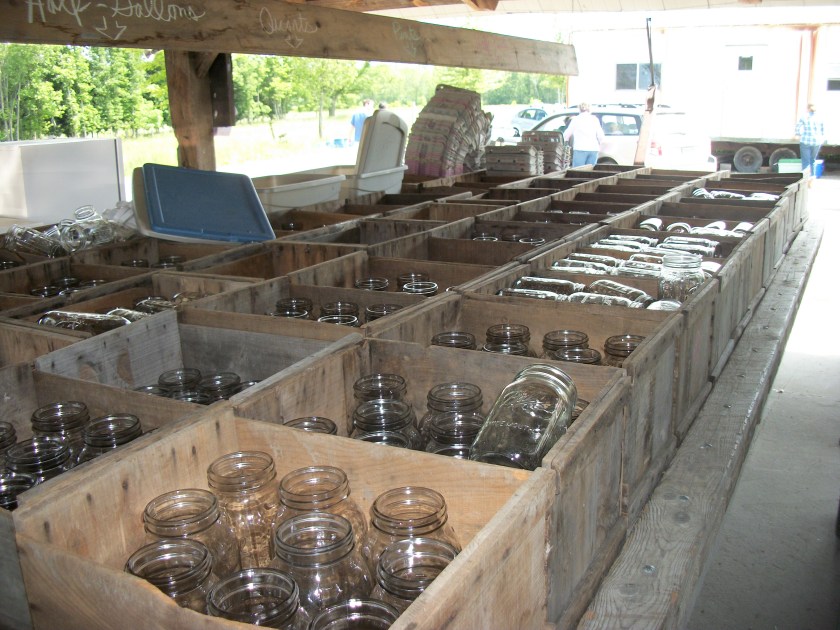Turkey Tracks: June 13, 2012
This is part 3 of a longer story. Scroll down for the beginning…
Visiting Essex Farm
When we arrived, we first saw a small flock of sheep in a fenced pasture alongside the farm road.
We knew that all of this farm equipment would be made for draft horses to pull.
There was a sheep mother nursing her baby just separated from this small flock–and Kristin told us later in our tour that Mark had just given her this flock for her birthday. Someone had gifted him with them, and he knew that Kristin had been wanting some sheep for some time. She’s now looking into animal guard dogs that are bred to live with and protect the animals in their care–as the sheep will be permanently pastured some way from the house. Essex Farm is 500 acres, which is a lot of land.
We parked and started down the driveway toward the farm buildings, and a small woman with very blue eyes and a big hat stepped from a group of people and said, “Hi, I’m Kristin.”
And, there she was–though she looked quite different from the picture on the cover of her book, THE DIRTY LIFE. Now there are no traces of the city. Her hair is long and braided, her fair skin glows with health, she’s lean and fit and muscular, and she radiates a very special kind of energy and interest that welcomes her guests to the farm.
There is a hint of some tension, and we soon learned that Mark had pulled a back muscle and was flat on his back at the farmhouse and in great pain and had care of the children. Somehow, people appear to take care of the children, to collect the eggs from the hen trailer to the north of the farmhouse, to let the horses out of the barn, to prepare a chili for the potluck lunch and for a fundraiser for the local Waldorf school later that evening–and so forth. It’s a Saturday morning–and the farm crew works, except in high-activity times, from Monday to Friday. (The CSA weekly food pickup is on Friday.) Kristin excuses herself from time to time, but makes us feel as if nothing on this earth is stressful or will get in the way of our visit. And those of us who had read her book knew that this kind of juggling is something she and Mark are well used to doing.
Kristin begins the tour by answering questions about the farm and how it works in the farm’s trailer–where work meetings and common meals take place. Half of this trailer is a field kitchen–the other half is filled with long tables. The walls are covered with lists, individual workers’ clip boards, maps of the farm, and so forth. We begin to realize that the administrative side of a diversified farm that feeds 220 people everything they need all year long is quite complicated. (This farm’s goal is to replace the grocery store with healthy, clean, nutrient-dense food.)
I love this picture of Kristin.
Outside the trailer is a huge refrigerated truck body and a long open building where CSA members pick up their food–it’s lined with freezer chests. We begin, though, by walking north, toward the farmhouse and the barns.
Here’s the farmhouse–and the window Kristin writes about in the book is still broken. The barns and other out buildings are beyond.
The fields near the farmhouse are the “home” fields and are reserved for herbs and flowers. Here’s a group of guests with Kristin in the chamomile flower row, helping to pull the flowers. Tara is in the blue plaid shirt on the left, in the front.
Kristin told us that chamomile tea is made with the chamomile flowers. She dries them and adds dried mint, lavender, and lemon balm–to make their tea–an idea that really appeals to me. I’ll be looking for some chamomile plants for this year and seed for the next. Here are the flowers:
We stop at a hoop house dedicated to raising meat chickens. The layers are in a tractor in a pasture beyond the barns and are moved daily. Each small pen within the hoop house houses chickens of different ages (one week, two weeks, etc.). When they are old enough to be ok with cool nights–which means they have grown enough feathers–they, too, are moved into tractors that allow them to free range on grass. I think, as with Joel Salatin’s Polyface Farm in Virginia, these chickens “follow” the cows as they rotate through pastures around the farm.
Here’s Tara holding a week old chick, whom she immediately wanted to take home!
These chickens are Cornish crosses, and those of you who read my blog know that I’m not a fan of them. I tried to interest Kristin in Freedom Rangers, but they had tried them and thought they took too long to develop and didn’t get as big as the Cornish crosses. They DO take longer, but that means, too, that their bones are really developed, can support their bodies, and have all the minerals they should have for really healthy bone broths. Before Cornish crosses, it would take 5 months or so to grow a chicken to roasting weight. Cornish crosses develop in SIX WEEKS! As for size, the FRs Rose raised were huge–often 6 or 7 pounds in 12 weeks. Rose does not have the space Kristin and Mark do, so the size/time taken may be a factor of supplemental feeding???
The farm is now powered by a bank of solar panels, which Kristin thought she would hate to see. But, she thinks they fit in surprisingly well. I think they got a grant to help install these panels… which, if true, is exactly the sort of help we need to be giving small, diversified farmers who are healing and using our farm lands.
The draft horses were just being let out of the barns as we drew near. These gentle giants are magnificent creatures. I think there are four teams here, but Kristin said on really busy days there are 5 or 6 teams in the fields as some of the workers also have teams of their own. The white pony belongs to the girls.
I didn’t know these draft horses came in a “paint” color. This one was really friendly. His partner is also a “paint.”
Gentle giants:
Kristin and Mark are in the process of “tiling” some of their fields as they are too wet. Tiling is a drainage method that puts a big pipe in a deep trench that drains the water from the field. Kristin feels that their area is getting wetter and wetter–which is something we are seeing in Maine as well.
They planted this rye crop in the tiled field, and it’s doing beautifully. They will harvest the grain and will bale the rye straw and use it for insulation in the home they want to build–a green building method that people are beginning to use more and more. See, for instance, the current issue of YES! magazine, which is available online. Straw comes from grain plants and hay is made from grass. (Kristin’s new book will be about building this home and will have more farm stories.) Here’s the rye field with the barns/outbuildings in the background.
The field that has the best dirt for growing produce is called “Small Joy,” and we are walking toward it.
Here are Kristin and Tara in front of Small Joy. You can see how long it is and how much has to be planted to feed 220 people year round. That’s garlic behind them. Garlic is planted in the fall, and the scapes, or flower pods, are just coming up now. Most garlic won’t winter over beyond about now, so it’s lovely to get the scapes in June. We cut them up and stir-fry them, put them in soups, put them into mayonnaise, and so forth. They have a light, lovely garlic taste.
We cross Small Joy and circle back to the house–by way of the sheep. After a fun potluck lunch–where Kristin adds in a fabulous chili with dried beans and sausage–all made on the farm–and bread with deep yellow spring raw butter–and sour cream–and lovely raw milk–I take these pictures of the shed where CSA members pick up their food. It takes a lot of Mason jars to put up food for the winter.
And here’s the working end of the meat chicken processing–open air, as it should be. The cones are where the chickens are suspended to drain out blood into the funnel below them. The table makes cleaning the chickens easy. there are also vats for hot water, a really good plucker, and a vat for cooling off the cleaned chickens. Everything can be washed off when the work is done.
We left Kristin and Essex Farm reluctantly. But everyone was tired and it was time to go. We didn’t see the highland cattle, or the pigs, or the sugar bush (maple syrup), or the borrowed dairy bull, or the dairy cows. And I didn’t take so many pictures I should have. I am particularly regretting not taking a shot of the buckets full of eggs from the layers–brought down from the upper pastures by a sweet young woman who stopped by to say “hi” and got drafted into helping out.
I could have stayed on that farm forever! It’s so full of life and love and energy and good things happening. It makes me think there is hope for healthy, nourishing, nutrient-dense food in America















